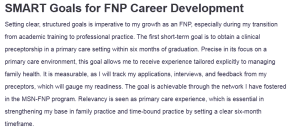SMART Goals for FNP Career Development
Setting clear, structured goals is imperative to my growth as an FNP, especially during my transition from academic training to professional practice. The first short-term goal is to obtain a clinical preceptorship in a primary care setting within six months of graduation. Precise in its focus on a primary care environment, this goal allows me to receive experience tailored explicitly to managing family health. It is measurable, as I will track my applications, interviews, and feedback from my preceptors, which will gauge my readiness. The goal is achievable through the network I have fostered in the MSN-FNP program. Relevancy is seen as primary care experience, which is essential in strengthening my base in family practice and time-bound practice by setting a clear six-month timeframe.
Notably, my second short-term goal is to build competence in managing chronic illnesses, especially diabetes and hypertension, within one year of graduation (Correia et al., 2019). This goal is specific since it targets chronic disease management, which is a critical aspect of patient care in primary settings. It is measurable by my completion of workshops and obtaining at least one specialized certification in chronic care. Available professional development programs will help me achieve the goal relevant to managing common conditions in diverse patient populations and time-bound by a one-year completion target.
In the long term, within the first three years of opening my practice, I will have a fully developed patient education program focusing on chronic disease prevention and management. By achieving this goal, patients will be empowered to actively participate in their health management through health literacy and self-care. It is measurable by patient satisfaction surveys and clinical outcomes, achievable with experience and resources accumulated, relevant to improving patient engagement in preventive care, and time-bound with a three-year goal. In so doing, I set a structured SMART goal path leading toward my vision as an FNP that focuses on impactful patient care and education.
References
Correia, J. C., Lachat, S., Lagger, G., Chappuis, F., Golay, A., & Beran, D. (2019). Interventions targeting hypertension and diabetes mellitus at community and primary healthcare level in low- and middle-income countries: A scoping review. BMC Public Health, 19(1). https://doi.org/10.1186/s12889-019-7842-6
ORDER A PLAGIARISM-FREE PAPER HERE
We’ll write everything from scratch
Question 
Week 6 – Initial Discussion – Smart Goals
Discussion Prompt
Setting goals is an important part of lifelong education and career planning. When USU FNP students consider their goals for their future careers, they should consider using the SMART principles, which have been around since the 1980s. SMART is an acronym that helps guide the formulation of goals that are:
-
- Specific (simple, sensible, significant).
- Measurable (meaningful, motivating).
- Achievable (agreed, attainable).
- Relevant (reasonable, realistic and resourced, results-based).
- Time bound (time-based, time limited, time/cost limited, timely, time-sensitive).

SMART Goals for FNP Career Development
Utilizing the concepts of S-M-A-R-T goals, in a table or in 100-250 words, please describe two to three short-term and one or two long-term professional SMART goals for after graduation. Make sure your goals are specific, measurable, attainable, realistic, and time-framed. Please comment on at least two peers’ goals.
Expectations:
- Length: A minimum of 250 words, not including references
- Citations: None required
Notes:
- If needed, the client is currently pursuing a MSN-FNP Program.